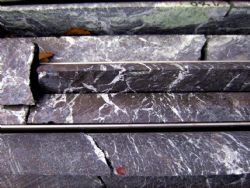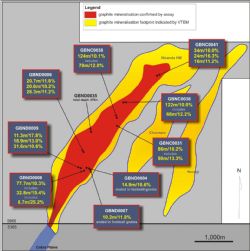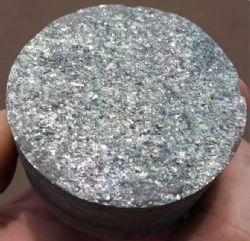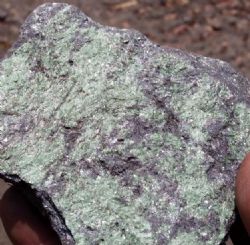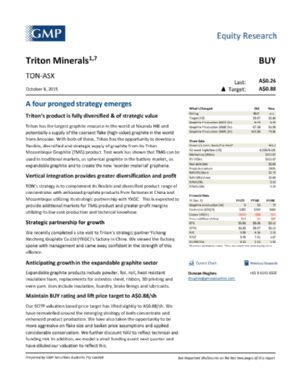
Further Positive Drilling Results From Nicanda Hill
Perth, Oct 9, 2014 AEST (ABN Newswire) - Triton Minerals Limited ( ASX:TON) ("Triton", "the Company") is pleased to confirm receipt of further assays and mineralogical results for the Nicanda Hill prospect.
ASX:TON) ("Triton", "the Company") is pleased to confirm receipt of further assays and mineralogical results for the Nicanda Hill prospect.
Triton Minerals Managing Director Brad Boyle said "Diamond drilling has again confirmed the world class potential of the Balama North project. To intercept substantial graphite mineralisation down to depths of 475m in single drill hole, with the mineralisation open at depth, combined with high grade graphite intercepts of up to 34.1% TGC, are again very exciting results.
The identification of a possible hydrothermal breccia zone and the confirmation that there is a substantial presence of large flake graphite throughout the 6.2km mineralisation footprint at various depths is very encouraging for Triton.
Further, the continued intersections of high grade graphitic and vanadium mineralisation in the mineralisation footprint reinforces the Company's belief that the Nicanda Hill prospect will become one of the world's largest multi-element projects. These latest drill results continue to provide a solid foundation for the initial large JORC 2012 resource at Nicanda Hill."
ADDITIONAL MINERALOGICAL RESULTS
The Company confirms that mineralogical and assay test work from SGS South African laboratory have returned encouraging results in line with previous studies, with head grades of up to 28% TGC, being obtained from the various samples. Further, these tests also confirm the strong presence of Vanadium within the graphitic samples, obtaining grades up to 0.50% V2O5 (Table 1 in Appendix 3 in link below).
The bulk sample used in the latest assay and mineralogical test work program at the SGS South African laboratory was obtained from several locations along the entire length of the mineralisation footprint. These samples were acquired from a number of locations and from various depths, including surface samples to drill core taken from up to 100m down hole on the Nicanda Hill prospect. These samples provide a more representative example of the type of graphitic material found across the whole of the mineralisation footprint.
The Company verifies that more detailed metallurgical and mineralogical investigations are progressing in conjunction with the graphite flotation test work program, as Triton is focused on refining the flotation methods for optimising the overall graphite recovery, final graphite concentrate grades and product size distribution.
Triton verifies that vanadium recovery test work also continues on the graphite flotation tailings. Initial analysis of the graphitic material confirms the vanadium is present in a flake form, which may lend itself to being beneficiated through the standard flotation methods. These initial vanadium tests found the high grade vanadium concentrate was being recovered from a full range of vanadium flake sizes.
Triton plans to undertake a detailed vanadium test work program focused on testing the flotation and other methods for optimising the overall vanadium recovery from the graphite tailings and the final vanadium concentrate grades.
GRAPHITE FLAKE DISTRIBUTION
Additional mineralogical investigations of the latest graphitic samples have provided more encouraging results and reconfirmed the substantial presence of large flake graphite (greater than 170um) throughout the Nicanda Hill prospect.
Triton reconfirms the mineralogical tests from various in situ samples obtained from across the mineralisation footprint, have again verified a range of graphite flake sizes from fines through to jumbo flake.
The Company verifies from the latest mineralogical test results, they show on average the graphite flake size distribution from the latest samples are as follows; 23% of the graphite samples are very large flake which are 212µm or larger, 36% are greater than 106µm (medium to large flake), 17% are greater than 75µm (medium flake), and 24% are less than 75µm (small flake) in size. These latest results are outlined below in Table 1.
-----------------------------------------Graphite Flake Sizes Flake Distribution----------------------------------------- +400um 7.3% +212um 15.9% +106um 36% +75um 17.1% -75um 23.7%-----------------------------------------
Table 1. Mineralogical Flake size distribution of the graphite as obtained from samples at Nicanda Hill.
The Company again notes the ratio of graphite flake sizes is unlikely to remain constant throughout the whole of the mineralisation footprint. However, given the wide-spread nature of the sampling, Triton believes these results are more representative of the type and sizing of the graphitic material found at the Nicanda Hill prospect.
Triton considers these additional in-situ flake size distribution results are very promising and will continue further test work to obtain a more detailed understanding of the physical characteristics of graphitic material throughout the 6.2km mineralisation footprint, in order to identify the most prospective areas for future mining activities, taking into account various graphite grades and flake sizing of the material identified to date.
Triton will continue working on an expanded metallurgical and mineralogical work program focused on testing the very large area of near-surface oxidised graphitic material which could potentially provide the Company with better overall graphitic grades and larger flake recovery.
Based on initial observations, the graphitic material in the northern prospects of the mineralisation footprint appears to host better graphite flake and grade within the weathered zone. Triton feels that if the metallurgical and mineralogical test work confirms these observations then the weathered zone in the northern prospects could possibly become the primary focus for Triton in the first 2-5 years of proposed graphite production.
Finally, the strong vanadium assay results has again increased Triton's confidence in the Nicanda Hill prospect, as a very large multi-element project and these results also underscore the potential importance of vanadium with respect to the overall future economics of the project when in production.
SIGNIFICANT ASSAY RESULTS
Triton has now completed the initial exploratory drilling program on the Nicanda Hill prospect, with sixty one (61) RC drill holes and thirty six (36) diamond drill holes finished, for a total 16,348m drilled.
Diamond hole GBND0035 located just south of drill section N4, was drilled to a total depth of 475m. Visual logging has confirmed the strong presence of graphite schist along the entire length of the drill hole, with narrow intervals of non-graphitic tonalite gneiss. The graphitic mineralisation was identified from close to surface, with the drill hole finishing in graphite mineralisation and remains open at depth.
The Company also notes the positive indications of a possible hydrothermal breccia zone, identified at depth within the northern section of the mineralisation footprint (Figure 1 in link below). This possible hydrothermal breccia zone, also appears to confirm the extension of the HG1 zone. This is potentially a significant observation as it may be one of the controlling factors influencing the creation of the enriched graphite mineralisation zone in the northern part of the mineralisation footprint at Nicanda Hill.
The Company again verifies that nearly all of the RC and diamond drill holes have finished in strong graphitic mineralisation and are open at depth. Triton confirms during this drilling program the average hole depth for the RC drill holes are 150m and 200m for the diamond drill holes.
These strong drill results continue to reaffirm Triton's overall belief in the potential of the Nicanda Hill prospect and that the graphite mineralisation intensifies and strengthens towards the north of the mineralisation footprint and with less internal dilution from a reduced number of gneiss (non-graphitic) bands.
These results continue to indicate the strong presence of graphite and vanadium and Triton is confident of further high grade interceptions.
In a recent site visit by Triton's CEO/MD, the strong presence of both graphite and roscoellite vanadium in the northern section of the mineralisation footprint was highlighted when a number of graphitic samples were inspected (Figure 3.)
Triton confirms about 45% of RC and Diamond drilling assay results have now been received from the SGS South African laboratory and the Intertek Genalysis laboratory. A full-suite ICP (multi-element) analysis including vanadium on all samples continues in laboratories in both South Africa and Australia.
Triton confirms these latest RC and Diamond drill holes continue to show substantial visible flake graphite and roscoellite from surface to the end of hole with many holes over 200m deep and open at depth.
The assay and visual drilling results continue to confirm strong graphite and vanadium occurrences over substantial thicknesses across the entire mineralisation footprint. Based on these results Triton is confident of further high grade intercepts on the Nicanda Hill prospect during future drilling campaigns.
CONCLUSIONS
The Company is encouraged by the continued excellent results and remains extremely confident that the Nicanda Hill prospect will become one of largest high-grade graphite and vanadium projects in the world.
These latest mineralogical results are very encouraging for Triton, as they have confirmed the substantial presence of large flake throughout the mineralisation footprint.
These latest drill results reaffirm the presence of multiple high grade graphite zones that are continuous and extend along the entire length of the mineralisation footprint for several kilometres from surface to depths in excess of 400 vertical metres.
The combined exploration and drilling data received to date continues to both enhance the geological robustness of the flagship Nicanda Hill prospect and support the rapid advancement towards another JORC 2012 compliant resource by the end of 2014.
Triton is optimistic of continued exploration success and looks forward to providing further exploration updates to the market as the information becomes available.
To view all tables and figures, please visit:
http://media.abnnewswire.net/media/en/docs/ASX-TON-694224.pdf
About Triton Minerals Ltd
 Triton Minerals Limited (ASX:TON) is an ASX listed, responsible mineral explorer and resource management company headquartered in Perth, Australia.
Triton Minerals Limited (ASX:TON) is an ASX listed, responsible mineral explorer and resource management company headquartered in Perth, Australia.
Led by a highly experienced management team, Triton Minerals' vision is to grow shareholder's value through discovery or development of base metal, gold and other precious metal deposits.
Triton has made excellent progress with its three Graphite projects located in the Cabo Delgado Province in Mozambique, with the program successfully identifying a number of graphitic exposures.
It is the Company's belief that the Mozambique, Balama North Project could host multiple and very substantial world class graphite deposits.
| ||
|



